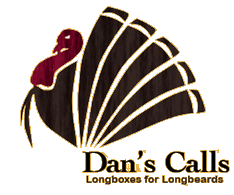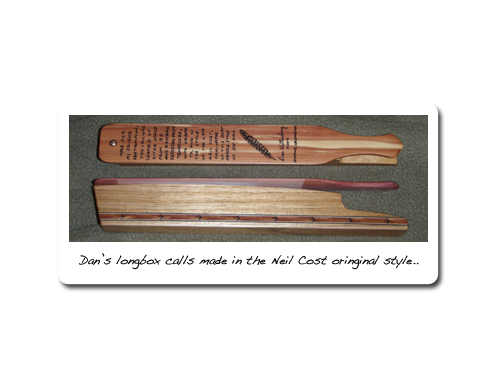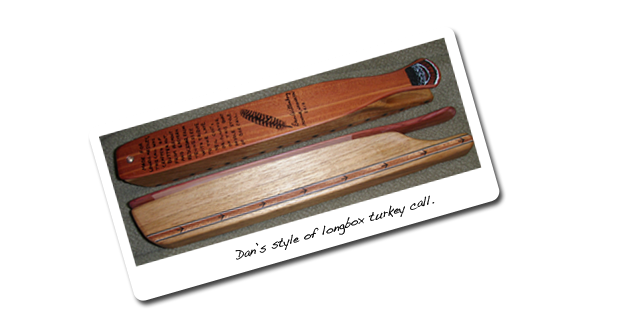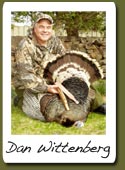About Dan's Calls
Philosophy

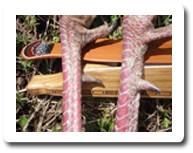
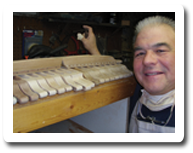
My philosophy is this: I want to make great sounding long box turkey calls that knowledgeable turkey hunters will cherish. I specialize in this one type of box call and I feel I do it very well. Why do I specialize in the long box? Because it works. I have noticed a pervasive opinion even among some experienced turkey hunters, that longboxes are just for locating. My self-assigned mission is to dispel the myth that long boxes are devices that are only useful for locating (but not necessarily attracting) gobblers. I respectfully submit to you that this versatile call is much more than a locator. It is an effective tool to bring Mr. Longbeard all the way to the gun. Try one and become enlightened. It is the only call I use. Why? Because it works.
My goal is to have very pretty calls that sound very good. Of these two concerns (appearance and sound quality) which takes priority? No contest. Sound quality takes priority, of course. Appearance is a secondary concern, but in the making of box calls, you kinda have to do the pretty details first and then hope you can make the call sound good. Although I pay a lot of attention to the details of the woodwork, my first priority is having realistic turkey sounds. After all, what good is a pretty call if it doesn’t sound like a hen? Some calls never do make the sound I’m looking for and they never leave my shop. I have a modest but growing collection of very handsome calls that will never bear my name and never be used in the woods because they don’t sound good enough. My criteria for determining if a call is ready to go to its new owner is this: I ask myself if I would be willing to hunt with this call, and this call alone, for an entire season. If the answer is yes, then the call is ready.
History
For the last ten years or so I’ve been making long box calls. I didn’t invent them. The late Neil Cost is generally credited with being the originator of this longer version of the box call. And while box calls have been around for over a hundred years, this longer variety of the box call didn’t really get going until the 1970’s. With Neil Cost being arguably the most noted box call maker in history, I have closely aligned my call making with his principles. Though he passed away before I got started, I have studied his teachings and I strive to achieve the quality of sound that he produced.
When I first started hunting turkeys, I used slates and diaphragms as a lot of guys do. I had a store-bought box call but never had much luck with it. But one spring day I was hunting with a friend who had a Neil Cost boat paddle call and he showed me what it could do. He called in three different longbeards that day and I became a believer. I borrowed his call and carved one just like it. Then another and another. Two years of trial and error later the calls were sounding much better and calling in birds well. I made a few for friends and then others started asking for them. So that’s how I became a call maker.
Call making for me is not so much a business as a passionate hobby. I make calls more so for the joy of getting an inanimate piece of wood to sing in a way that will make a tom turkey come looking for the “hen” that he has just heard. I make each call by myself, by hand…. the shaping, rasping, sanding, and finishing. The inlaying, the tuning, the case, all of it. Each one takes about 15 hours of my time. Most of my call making is done in the winter in preparation for spring season. But in the spring, when I'm chasing turkeys, my call making is on hold. Other times of the year I have other things I like to do like fly fishing, bass fishing, bow hunting deer, traveling. I have imposed a limit of 30 calls per year on my production. That is all I feel I can handle and still keep very high standards for sound quality. Call making is not how I make a living. I am, in fact, retired and living the dream.
Long Box Construction
I specialize in making long box calls. They are sometimes called paddle boxes, or boat paddle calls. Mine are 12.5 inches long. Neil Cost is generally regarded as the originator of this longer style of box call. My first calls I made were copies of Neil Cost’s traditional boat paddle style. Later, as I gained in confidence and sound quality, I made cosmetic changes to the appearance of the call, making the lines more rounded and changing the shape of the handles. I settled on a rounded fan-shaped handle for the lid which later looked to me like a turkey tail. I painted some of those handles to look like a turkey tail and people liked them. So the style with the painted tail on the handle stuck and it’s what I refer to as Dan’s style, for lack of a better name. Some prefer the traditional Neil Cost look but about 80% of the calls I sell are Dan’s style. The guts of the two styles (the internal geometry of the box) are the same and they both produce great sounds. All my boxes are hewn from a solid piece of high quality straight-grained wood. The lid and the box are loosely joined with a quality bronze wood screw. Most short box calls have a small coil spring around the screw to keep the lid in a level position. However, with long box calls there is no spring and this is on purpose. I explain why in the instructions. No glue is used in construction, except for securing the decorative inlay.
The exterior of my calls is protected with a polyurethane finish. Though this varnish is impervious to water, you should strive to keep your call dry. I use no stains to alter the wood’s natural color.
Wood Types
Most of these woods are native to North America. Of the woods listed, Butternut and Sitka Spruce are my “go to” woods. These two woods account for more than 90% of the calls I make. I am always confident of getting the sweet hen sounds that I seek from either of these woods. Other woods work well but these are the ones I keep coming back to. I have experimented with numerous other woods and will do them on request. All of my lids are made of Eastern Redcedar, also called aromatic cedar or Tennessee Cedar.
The woods I use for the box portion of the calls are listed here:
- Butternut (Juglans cinerea)
- Sitka Spruce (Picea sitchensis)
- Mahogany (Khaya species)
- Yellow Poplar (Liriodendron tulipifera)
- Alaskan Yellow Cedar (Callitropsis nootkatensis)
- Bald Cypress (Taxodium distichum)
- Eastern Redcedar (Juniperus virginiana)
Inlay Banding
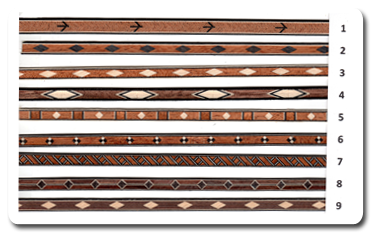
For several years I have been adding decorative inlay banding along the base of the box. For a modest increase in materials and labor I feel I get a much nicer looking call with inlay banding. I use inlay banding of several different patterns. And I now (2010) have an inlay banding which was custom made for me by Matt Furjanic of Inlaybanding .com in North Carolina. It features turkey tracks of ebony on a field of rich mahogany and enclosed by layers of maple and ebony. Most of the other fine patterns I use come from Acutemarquetry.com in Maryland.
Tail Art
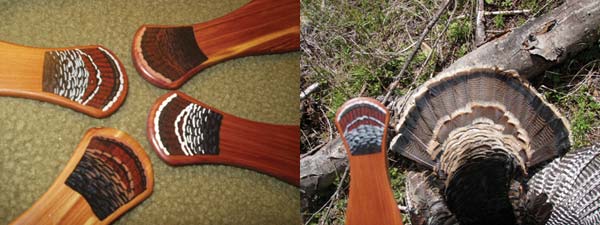
On the rounded handles of my lids I paint the tail plumage of the wild turkey. You may specify which you prefer, Merriams or Eastern.
Notches and Grooves
I’ve been asked about the notches in the handles of my personal calls. When I first started making calls I would put a small notch in the handle of the box call for each gobbler I called in to shotgun range with that call. It was an informal way to document the relative successes I’d had with various box calls. And it’s sort of a tongue-in-cheek tribute to the gunslinger days. I’ve carried on that personal tradition. The spring of 2009 was my best season yet, with 60 notches.
Additionally, my calls often have grooves cut into the inside of the sound boards. This is a tuning technique. This technique of grooving is sometimes seen on the outside of shorter box calls and sometimes is done in the form of checkering. Either way, its use is more than decorative. The intent is to loosen up the stiffness of the sound board for the purpose of getting it to resonate better while still allowing it to retain most of its original mass.
My “Dan’s” style calls also have two sculpted features on the box handle. The first is a thumb groove. Neil Cost occasionally put an ink thumb print on the side of the long box to remind the user to not hold the call any further forward on the sound board. Doing so might dampen the vibrations and therefore the sound. On my calls I instead put a shallow depression in the wood at that location. The second feature is the grooves near the end of the box handle. I put those there to provide a better grip on the call handle when you are operating it upside down, with the screw end of the call pointed toward the ground.
Inscriptions

On the lid of the call I write in black ink and then sign and date the call. If you do not have a preference, it will read similar to this. MADE FOR JOHN DOE, THIS CALL WAS CRAFTED OF BUTTERNUT FROM VERMONT AND EASTERN REDCEDAR FROM TENNESSEE, WITH TRIBUTE TO THE LATE NEIL COST, ORIGINATOR OF THIS BOAT PADDLE STYLE OF BOX CALL. (signed) Dan Wittenberg SPOKANE, WASHINTON 2010 There is a number on the inside of the call that indicates its sequence in what is now over 200 calls.
Awards

Our Washington state chapter of NWTF annually hosts a competition for turkey call makers in the state. In 2006 my longbox entry won the Board of Directors Best Overall award. That amounts to Best of Show. I don’t much compete in regional and national competitions. They usually come at time of year when I’m busy making calls for my customers.
About the Cases

Let’s face it, a longbox call is bigger than most any calling device you might want to carry in the woods. Shoved in vest pocket, it might get dirty or damaged and it can rattle and squeak at the wrong moment. I feel that a long box should be paired with a case which is engineered to work as a system with the call. The case should be designed to keep the call dry, protected and quiet. It should blend in well in the turkey woods. And it should keep the call ready for action at a moment’s notice. I provide such a case with each of my calls. It is made of fabric-backed vinyl such as Naugahyde, and is padded with thick Berber fleece. The case is available in shades of brown or green. It has pockets which hold the chalk and other small items. It has a belt loop but the case seems to function better when carried higher on the body. I have included convenient tabs and large safety pins so that you can attach the case to your hunting vest or clothing as you see fit.
